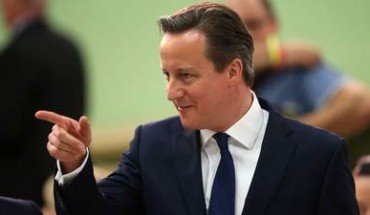David Cameron has reached out to Conservative backbenchers in a bid to ensure his slim majority is workable in the House of Commons.
The Prime Minister has already held a meeting with Graham Brady, the chair of the 1922 Committee that represents the party’s backbenchers.
The pair met in Downing Street immediately after the election result on Friday – underlining how important the issue is to Mr Cameron.
:: See Our Election 2015 Section
Mr Brady, the MP for Altrincham and Sale West, told Sky News he was pleased his party would no longer be “constrained” by Lib Dems in a coalition.
“It’s going to be possible with a Conservative majority to deliver some of the pledges and promises that we’ve made,” he said.
“Things like the referendum on European Union membership, which is so important to a great many people in the country. We know that we can deliver them.
“Because we have a majority, we can’t be constrained by another party that might wish to stop us doing so.”
He argued that the structure of the new Government would mean the Prime Minister would have to work constructively with the party and would also mean more ministerial positions for Conservatives to be promoted into.
With a majority of just 10, Mr Cameron will have to keep down rebellion on his own backbenches to make sure that votes on policy can be passed through Parliament.
One group of Tory staffers decided to hold a Club Tropicana themed party to celebrate the election result. That, they said, was because of the year the song came out. 1983 was the last time an incumbent Prime Minister increased their party’s number of seats after an election.
But Margaret Thatcher had a much bigger majority back then than David Cameron has in 2015. It is why he might find himself beholden to Tory backbenchers – because he will need almost all of them to get votes through Parliament.
Some observers suggest that could get just as tricky as negotiating with coalition partners- which might explain the early hand to Mr Brady.
It comes after the Liberal Democrats were annihilated in the General Election, losing 85% of their Parliamentary party, leaving them with just eight MPs.
Nick Clegg’s party had hoped to be kingmakers once again, as they were in 2010, but instead he had little choice but to quit as leader despite keeping his own seat in Sheffield Hallam.
One senior Lib Dem source said he was “devastated”, describing the night as “utterly horrific”.
The party will now commence a leadership election with any of the MPs able to put themselves forward – as to do so requires the support of one 10th of the parliamentary party.
The front runner is Tim Farron – a popular figure on the left, followed by former mental health minister Norman Lamb. The election would take place in two to three months’ time with one vote for every member.
A single transferable vote system would be applied, under which if one person fails to get 50% support then second preferences are also counted.
The Conservatives went out of their way to target Lib Dem seats during the election campaign, including successfully overturning Vince Cable’s majority of over 12,000 in Twickenham and David Laws’ majority of over 13,000 in Yeovil.
The party was wiped out in the southwest of England. Some had warned that the Tory strategy would strip them of a potential coalition partner, but in the end they did not need it.
However, Mr Cameron could struggle to maintain stability in his Government with such a small majority. On some issues, such as gay marriage, the Conservative leader is probably more aligned to Lib Dems than to he is to those on the right of his own party.
They may want to use the new majority as a way of making their own policy demands, much as the Lib Dems did during the last coalition.
Source: Skynews

